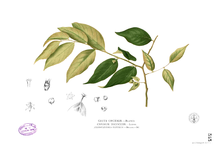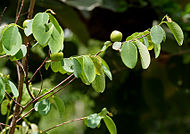- Cleistanthus
-
Cleistanthus 
Cleistanthus orgyialis Scientific classification Kingdom: Plantae (unranked): Angiosperms (unranked): Eudicots (unranked): Rosids Order: Malpighiales Family: Phyllanthaceae Tribe: Bridelieae Genus: Cleistanthus
Hook.f. ex Planch.Species - Cleistanthus apodus
- Cleistanthus collinus
- Cleistanthus cunninghamii
- Cleistanthus hylandii
- Cleistanthus sumatranus
- Cleistanthus schlecteri etc.
Cleistanthus is a plant genus of the family Phyllanthaceae. The genus comprises 140 species, found from Africa to the Pacific Islands. Cleistanthus collinus is known for being toxic and frequently used for homicidal or suicidal purposes.
Synonymy
The genus is also known as:
- Clistanthus Post & Kuntze, orth. var.
- Godefroya Gagnep.
- Kaluhaburunghos Kuntze
- Lebidiera Baill.
- Lebidieropsis Müll.Arg.
- Leiopyxis Miq.
- Nanopetalum Hassk.
- Neogoetzia Pax
- Paracleisthus Gagnep.
- Schistostigma Lauterb.
- Stenonia Baill.
- Stenoniella Kuntze
- Zenkerodendron Gilg ex Jabl.
Description
Cleistanthus collinus is a plant poison also called "oduvan" (Tamil). Ingestion of its leaves or a dicoction of its leaves causes hypokalemia (kaliuresis and cardiac arrythmias [1]), metabolic acidosis, hypotension and hypoxia [2] probably due to distal renal tubular acidosis, ARDS and toxin induced vasodilatation respectively [3, 4, 8]. Hypokalemia and acidosis probably also induces rhabdomyolysis resulting in myoglobinuric renal failure and neuromuscular weakness[5]. Its effects are probably mediated by injury to the distal renal tubules, pulmonary epithelium and peripheral blood vessels due to glutathione depletion [6] (animal studies have shown benefit with N-acetyl cysteine [7]).
References
1. Thomas K, Dayal AK, Narasimhan, Alka G, Seshadri MS, Cherian AM, Kanakasabapathi, Molly B. Metabolic and Cardiac effects of Cleistanthus Collinus poisoning. J Assoc Physicians India 1991; 39(4): 312–314.
2. Subrahmanyam DK, Mooney T, Raveendran R, Zachariah B. A Clinical and laboratory profile of Cleistanthus collinus poisoning. J Assoc Physicians India; 2003 Nov; 51:1052-4.
3. S. Eswarappa, A R Chakraborty, B U Palatty, M Vasnik; Cleistanthus Collinus Poisoning: Case Reports and Review of the Literature. Clinical Toxicology, 2003; 41(4), pp 369–72.
4. Benjamin SPE, M Edwin Fernando, JJ Jayanth, Preetha B; Cleistanthus collinus poisoning. J Assoc Physicians India; 2006 Sep; 54:742-44
5. S. Eswarappa, Benjamin SPE; Renal failure and neuromuscular weakness in Cleistanthus collinus poisoning. J Assoc Physicians India; 2007 Jan; 55:85-86.
6. Sarathchandra G, Balakrishnamoorthy P; Acute toxicity of Cleistanthus collinus, an indigenous poisonous plant in Cavia procellus. Journal of Environmental Biology 1998, pp 145–8.
7. Annapoorani KS, Damodaran C, Chandrasekharan P. A promising antidote to Cleistanthus collinus poisoning. J Sci Soc Ind 1986; 2:3-6.
8. Nampoothiri K, Chrispal A, Begum A, Jasmine S, Gopinath KG, Zachariah A. A clinical study of renal tubular dysfunction in Cleistanthus collinus (Oduvanthalai) poisoning. Clin Toxicol (Phila). 2010 Mar;48(3):193-7.
This Phyllanthaceae article is a stub. You can help Wikipedia by expanding it.

